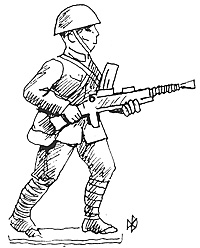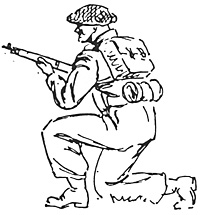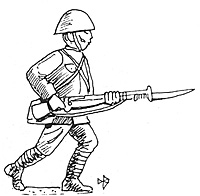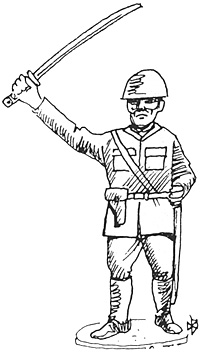 Introduction
Introduction
This is a World War 2 skirmish game set at squad level and uses a 1:1 figure to man ratio. In order to play the game you will need model figures and terrain, a standard deck of playing cards, a deck of cards for each squad (yours and the enemy), 3 standard 6 sided dice (D6) and 1 Average die.
Brief Historical Background
By early 1942 the Japanese had swept all before them in the Pacific theatre. They had a fearsome reputation and it was believed that there was no one who could stand against them, especially when it came to jungle warfare. However the attempt to take Port Moresby in New Guinea was to show that they were not invincible and that the allies knew a thing or two about fighting in the jungle.
The Japanese had intended a sea-borne invasion of Port Moresby, but the Battle of the Coral Sea changed all that. The Japanese regulars were soon locked in a grim fight with the allies across New Guinea’s mountainous interior. The Japanese HQ was at Buna on the north coast of the island. Their objective was Port Moresby (the allied HQ) on the south coast.
 The Allied force consisted of Australian regulars and the New Guinea Volunteer Rifles (NGVR). The allied task was to monitor Japanese progress and harass the enemy as much as possible. The Kokoda Trail runs north-east, south-west across the eastern extremity of the island. It runs through mountainous terrain which is thickly forested.
The Allied force consisted of Australian regulars and the New Guinea Volunteer Rifles (NGVR). The allied task was to monitor Japanese progress and harass the enemy as much as possible. The Kokoda Trail runs north-east, south-west across the eastern extremity of the island. It runs through mountainous terrain which is thickly forested.
The whole campaign lasted three months (August to September 1942) and ended with an allied victory. Conditions were difficult with both sides finding it hard to re-supply and suffering as much from illness as from enemy activity.
Campaign Mechanisms
The first thing to note is that there is no map. Instead we use a Campaign Track. Decide whether you are Japanese or Australian and place a counter on the track at Start (you knew that!). Move to mission #1 which is “patrol to contact and take a prisoner.” After you have achieved this go on to mission #2, then mission #3 and so on. Should you fail at a mission go back to the previous one. If you fail at the first mission move to mission #1 on your opponent’s side. The first to reach the enemy HQ is the winner.
The Campaign Track (each segment counts as one week in the field)
- Japanese HQ @ Buna
- 5 Attack enemy HQ; stretched supply line; attacker +2 blanks
4 Aggressive patrol; defenders+2 blanks
3 Take objective (airfield, supply dump, river crossing, etc.)
2 Aggressive patrol against an out post; defenders +1 blank; attackers-1 blank
1 Patrol to contact, take a prisoner
START
1 Patrol to contact, take a prisoner
2 Aggressive patrol against an out post; defenders +1 blank; attackers-1 blank
3 Take objective (airfield, supply dump, river crossing, etc.)
4 Aggressive patrol; defenders+2 blanks
5 Attack enemy HQ; stretched supply line; attacker +2 blanks
Australian HQ @ Port Moresby
 Squad Selection
Squad Selection
The squad is selected randomly by drawing cards from a deck. Historically a squad would be ten or twelve rifle men plus support (machine gun and mortar) if available. Each crew served weapon (mortar and machine gun) has one card regardless of crew numbers. Whatever you decide on as your basic rifle squad, have a ratio of 2:1 soldiers and blanks in the initial squad deck. So my original mix in the deck is 14 cards (one for each rifle man and plus one for a mortar and one for a medium machine gun) plus seven blanks. Make the additions and subtractions suggested by the scenario and throw 3D6. Draw this number of cards from the deck to see what your squad comprises.
Further additions and subtractions
In New Guinea staying healthy was a problem. After three weeks in the field, add four cards to the squad selection deck with “illness” written on them.
If you won the last battle remove one blank card (good morale).
Casualties: remove the appropriate cards from the deck.
Illness: remove one squad member (if you draw this card look at your squad and take one soldier out before you begin the scenario. He can go back in the mix for the next scenario).
Command and control
Make up two cards for each squad member (yours and the enemy) and add one card with STOP on it. When a soldier’s card is turned over he can take an action (move, fire, move and fire, fire and move). When the STOP card is turned over that is the end of the turn. Shuffle all the cards together and begin the next turn.
Movement
- Normal 3
Cautious 2
Fast 4
(The numbers under movement and shooting refer to numbers of hexes because my tabletop has a 60mm hex grid superimposed upon it. Substitute your own local movement rates and ranges).
Shooting
- Rifle anywhere on the table
LMG (e.g. Bren) 40
SMG (e.g. sten) 10
Other Machine Guns anywhere on the table
Revolver 25
Mortar 5 - anywhere on the table
Grenade 3
Clear line of sight required
Rifle/revolver turn over three playing cards
SMG turn over 4 cards
Other MG and mortars turn over 5 cards
To hit a target in the open any JQK
To hit a target in cover any red JQK
Hand to Hand
Designate a colour to one side (e.g. Australian = red) Turn over three cards; the majority colour wins.
Combat Effectiveness
Combat effectiveness is measured on the chart. Each squad member turns over three playing cards. Aces count as one, Jacks eleven, Queens 12 and Kings 13. Add together the number of spots and this is the soldier’s combat effectiveness rating. This gets reduced as the scenario wears on.
- Soldier #
1 2 3 4 5 6 7 8 9 10 11 12 13 14 15 16 17 18 19 20 21 22 23 24 25 26 27 28 29 30 31 32 33 34 35 36 37 38 39
Each time a soldier is fired at but missed -1
Each time fired on by grenade/mortar but missed -2
Each time the soldier is fired at and hit -1 Average die score
Each “fast” move -1
When combat effectiveness is reduced to zero the soldier cannot continue due to wounds and exhaustion. After the scenario roll 2D6. Any double and the soldier dies from his wounds.
Combat effectiveness is cumulative from scenario to scenario.
You may want to rest one or two of your squad if their combat effectiveness is low.
For each week the soldier spends out of the line (up to a maximum of three) he can replenish his combat effectiveness. e.g. one week out of the line turn over one card and add that to your combat effectiveness. A soldier rested for two weeks may turn over two cards and so on.
 An example of squad selection
An example of squad selection
I’ve decided to be the Australians and I have already successfully completed mission #1, taking a prisoner. Fortunately all of my soldiers survived, but my machine gun team are close to exhaustion, having only 4 combat effectiveness points left. I decide to rest them for this scenario and take them out of the card selection.
The scenario, mission #2 is an aggressive patrol against an outpost; the defenders (Japanese) add one blank to their card selection; the attackers (Australian) take a blank out. Because we (Australians) won the last mission we can take another blank out.
So the potential Australian squad is 12 riflemen and a mortar (13 cards) plus 5 blanks (7, -1 for the scenario specific, -1 for winning the last encounter), a total of 18 cards. I roll 3D6 and score 15. Of the 15 cards that I turn over 4 are blanks. I have a squad consisting of 10 riflemen and a mortar crew (useful for attacking a Japanese strongpoint). Let’s hope this is enough to get the job done.
Follow through the same procedure to determine the Japanese squad. Fight out the mission and move to the appropriate space on the Campaign Track. The next scenario marks the third week in the field and the illness cards will come into play.
The squad selection mechanism poses significant questions for the commander, especially as the campaign wears on. Do we risk putting soldiers in the field when they are close to exhaustion? Do we have the option? Remember if the soldier’s combat effectiveness is reduced to zero he could die of his wounds (any double on 2D6), but you may have no choice. You may need the sort of firepower that a machine gun team can offer at this stage in the campaign.
Perhaps this gives us a feel for what it may have been like for commanders as they watched their battle weary troops returning to base, knowing that all too soon, they would have to be out in the field again.
Additional Rules
Although the Japanese did have some tanks in the coastal sector in the north of the island, the Kokoda Trail was essentially an infantry fight. Below are some additional rules for those who want to move this to a different theatre and use some additional weaponry.
Small arms fire (revolvers, rifles, SMGs) has no effect on armour or softskins, but they do kill exposed crew members.
- Armour
Any Jack, Queen or King is a hit.
Red is a hit on the turret, no firing.
Black is a hit on the tracks, no movement.
Any pair of Jacks, Queens or Kings the same colour destroys the target.
Softskin
Any Jack, Queen or King destroys the softskin.
Afterword
I wanted a game which was fast moving and simple. I also wanted a game which centred on the effectiveness of the individual soldier on the ground. The Combat Effectiveness Chart is the heart of this system. It is a combined morale and wound chart. This is why you lose a point for being shot at, but missed. Many soldiers testified to the fact that they were afraid and froze when they were shot at. In the terms of the game their combat effectiveness is reduced.
Have a go at this and see what you think. Let me know what you think via the Forum.
Back to Table of Contents -- Lone Warrior # 150
Back to Lone Warrior List of Issues
Back to MagWeb Magazine List
© Copyright 2005 by Solo Wargamers Association.
This article appears in MagWeb.com (Magazine Web) on the Internet World Wide Web.
Other articles from military history and related magazines are available at http://www.magweb.com
